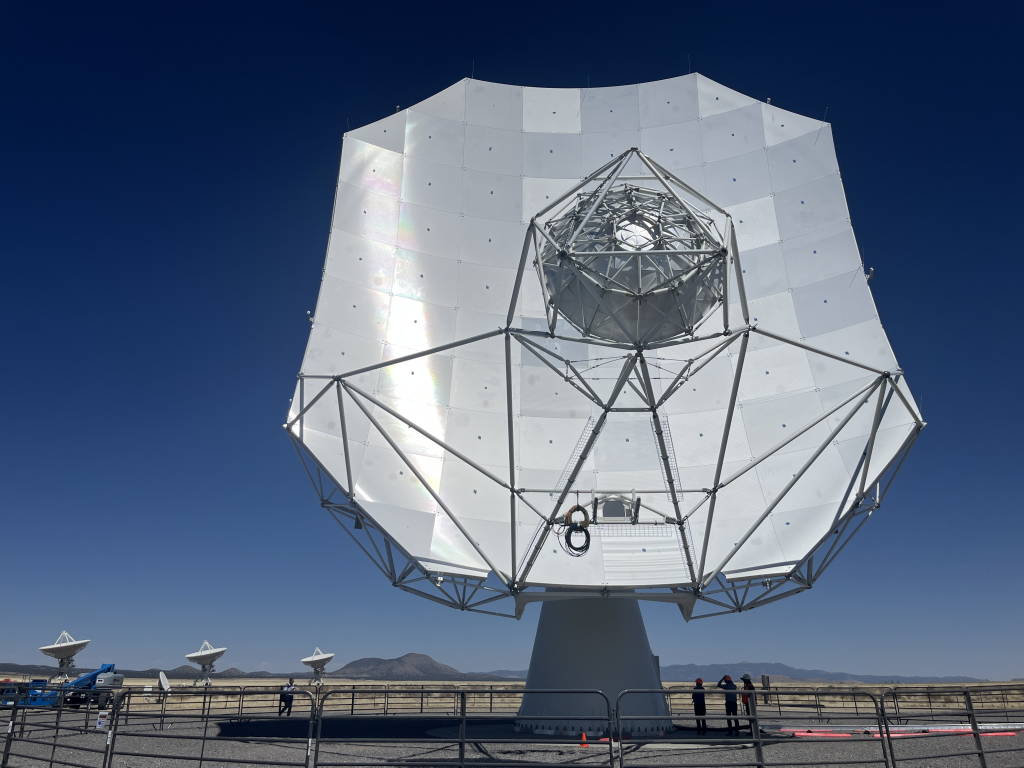The U.S. National Science Foundation National Radio Astronomy Observatory (NSF NRAO), in partnership with several leading Mexican universities and research institutes, has announced a series of landmark agreements and meetings aimed at advancing Mexico’s role in the Next Generation Very Large Array (ngVLA) project.
Recent News
Astronomers Discover a Superheated Star Factory in the Early Universe
Astronomers have uncovered a previously unknown, extreme kind of star factory by taking the temperature of a distant galaxy using the ALMA telescope. The galaxy is glowing intensely in superheated cosmic dust while forming stars 180 times faster than our own Milky Way.
Astronomers Share Largest Molecular Survey To-date: GOTHAM Legacy Data Goes Public
Astronomers in the “GBT Observations of TMC-1: Hunting Aromatic Molecules” research survey, known as GOTHAM, have released a spectral line survey with largest amount of telescope time ever conducted, charting more than 100 molecular species only found in deep space.
NRAO and Johns Hopkins University Launch ngVLA Partnership

A groundbreaking collaboration harnesses data science and radio astronomy to unlock the universe’s deepest secrets with the next generation Very Large Array
The U.S. National Science Foundation National Radio Astronomy Observatory (NSF NRAO) and Johns Hopkins University (JHU) are thrilled to announce a new partnership aimed at revolutionizing the field of radio astronomy and multi-messenger astrophysics. This collaboration, formalized through a Memorandum of Understanding (MOU), brings together two leading institutions to support the next generation Very Large Array (ngVLA) and future U.S. radio astronomy initiatives.
The ngVLA, currently under development, will be a state-of-the-art radio telescope array offering more than ten times the sensitivity and spatial resolution of the current NSF Very Large Array (NSF VLA.) Operating across a wide range of frequencies, the ngVLA will enable astronomers to explore the universe with unprecedented detail. Once completed, the ngVLA is expected to become the premier national facility for ground-based radio astronomy, opening new frontiers in our understanding of black holes, neutron stars, galaxy evolution, and the cosmos itself.
This partnership leverages JHU’s strengths in data science, artificial intelligence, and astrophysics, aligning with their investments in the Data Science and AI Institute and their leadership in multi-messenger astronomy. By combining the NSF NRAO’s expertise in radio astronomy with JHU’s cutting-edge computational resources, the collaboration will tackle the immense data processing and analysis challenges posed by the ngVLA and future astronomical surveys.
“The multi-messenger discovery of GW170817—the first binary neutron star merger detected in gravitational waves and light at all wavelengths—has transformed the way we study the transient sky and how we learn about the physics of the most exotic objects in the stellar graveyard” says Alessandra Corsi, W.H. Miller Professor in the Physics and Astronomy Department at JHU. “Thanks to a variety of efforts that the scientific community is undertaking, over the next decade we could transform a trickle of multi-messenger discoveries into a flood. The goal of the NRAO-JHU partnership is to address some of the key challenges that lie ahead of this transformation. It represents an exciting opportunity to bridge radio astronomy, data science, and AI.”.
Key highlights of the partnership include:
- Collaborative Development: Joint efforts to develop efficient strategies for observing, processing, and archiving the vast datasets generated by the ngVLA and other radio facilities.
- Data Science Innovation: Utilizing JHU’s advanced computing infrastructure to support data reduction and analysis, ensuring that scientists can quickly and effectively interpret the flood of new discoveries expected in the coming decade.
- Multi-messenger Breakthroughs: Coordinated efforts to follow up on gravitational wave events and other cosmic phenomena, combining radio observations with data from gravitational wave detectors and optical telescopes to unlock the secrets of the universe.
- Training and Engagement: Opportunities for faculty, students, and staff from both institutions to collaborate, innovate, and drive the next wave of astronomical discovery
“This MoU marks a pivotal step as the astronomical community prepares for a new era of discovery, powered by the ngVLA and the synergy between NRAO and JHU,” adds Eric Murphy, NSF NRAO ngVLA Project Scientist. Together, these institutions are poised to transform how we explore the universe, making groundbreaking science possible and inspiring the next generation of astronomers.”
About NRAO
The National Radio Astronomy Observatory and the Green Bank Observatory are major facilities of the U.S. National Science Foundation, operated under cooperative agreement by Associated Universities, Inc.
This news article was originally published on the NRAO website on May 19, 2025.
Recent News
NSF National Radio Astronomy Observatory and Mexican Institutions Sign Historic Agreements to Advance ngVLA Collaboration
The U.S. National Science Foundation National Radio Astronomy Observatory (NSF NRAO), in partnership with several leading Mexican universities and research institutes, has announced a series of landmark agreements and meetings aimed at advancing Mexico’s role in the Next Generation Very Large Array (ngVLA) project.
Astronomers Discover a Superheated Star Factory in the Early Universe
Astronomers have uncovered a previously unknown, extreme kind of star factory by taking the temperature of a distant galaxy using the ALMA telescope. The galaxy is glowing intensely in superheated cosmic dust while forming stars 180 times faster than our own Milky Way.
Astronomers Share Largest Molecular Survey To-date: GOTHAM Legacy Data Goes Public
Astronomers in the “GBT Observations of TMC-1: Hunting Aromatic Molecules” research survey, known as GOTHAM, have released a spectral line survey with largest amount of telescope time ever conducted, charting more than 100 molecular species only found in deep space.
